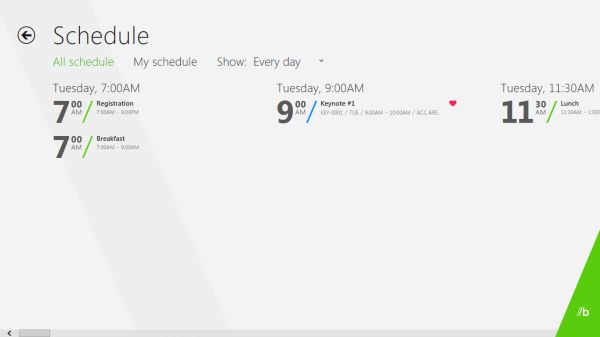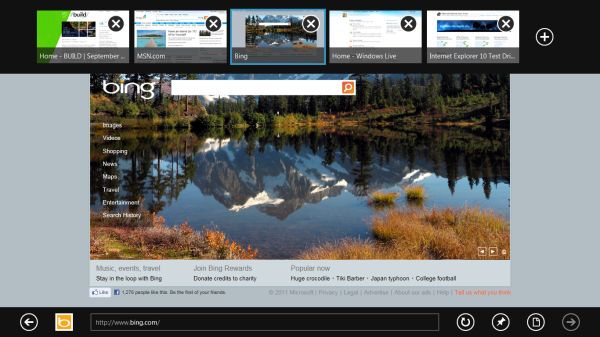Microsoft BUILD: Windows 8, A Pre-Beta Preview
by Brian Klug & Ryan Smith on September 13, 2011 12:05 PM EST- Posted in
- BUILD
- Windows
- Microsoft
- Windows 8
- Trade Shows
The Desktop User Experience & Business Use
While we’re primarily focusing on Windows 8 as a tablet OS since the hardware we used was a tablet, we also wanted to evaluate it some as a desktop OS. As the sample tablet was compatible with Bluetooth peripherals, we were able to pull out a BT keyboard and mouse and use it like a traditional laptop/desktop environment. With that said I’d like to preface our impressions with the following: as it stands Windows 8 is clearly focused on tablets first and Microsoft’s presentation was equally tablet focused, and it’s almost certain the experience will change before Windows 8 ships.
Overall Windows 8 is extremely jarring right now from a desktop user perspective. Metro is the Windows shell, no ifs ands or butts. Metro applications can only be accessed through the Metro shell (i.e. the Start Screen), and the Metro shell is always what the tablet will boot up into. Explorer as we know it is the Metro shell – if you kill it, you kill Metro shell with it – so at this time it’s not possible to boot up into the traditional Windows desktop. Even if you could, the Start Menu is gone, replaced with Metro charms.
So what we’re really evaluating is the ability to use the Metro shell and Metro applications with a mouse. For all the good Microsoft has done implementing multi-touch, the mouse has clearly suffered as it currently stands. Click & drag does not operate the same as tap & drag, which creates some oddities when you want to scroll around. In fact scrolling is probably the biggest oversight right now, as the Metro style dictates applications are laid out left-to-right rather than top-to-bottom. The mouse wheel will (slowly) scroll through tiles on the Start Screen, but in other places such as the Microsoft BUILD application the mouse wheel is useless. In its place you have to drag a scroll bar around, which is about as fun as it was prior to mice coming with a wheel.
Internet Explorer is particularly weird. Because it takes the full screen approach there isn’t a menu bar to speak of, and the tabs and URL bar are hidden. Invoking them requires right-clicking, with right-clicking pulling double duty as a way to open a link in a new tab and invoking the various bars. This also means that right-clicking for other purposes (e.g. View Source, etc) are unavailable.
The good news is that most of the traditional keyboard shortcuts still work, including Alt-Tab, WinKey + D, WinKey + E, and Ctrl-Alt-Esc. You can even Alt-Tab between launched Metro applications. The Start Menu search bar is also faithfully replicated on the Start Screen, so when you start typing Windows 8 will start narrowing down results of things to open. So overall keyboard users maintain much of their advantage in quickly executing applications. At the same time we’ve encountered fields that we can’t tab to, so not everything is working as it should.
While we’ve only had a short period of time work play with Windows 8 with a mouse and keyboard, at this point in time there’s not a lot to say that’s positive. Metro works well as a tablet interface, but with a mouse and keyboard it’s like using a tablet with a mouse and keyboard. Hopefully Microsoft will have a more suitable mouse & keyboard control scheme ready to go for Windows 8 farther down the line.
Windows 8 the Business OS
So far Microsoft has been focused on the consumer side of Windows 8, but business users won’t be left out in the cold. Windows 8 will also be the basis of a new version of Windows Server (also using Metro), and Windows 8 clients will have some new features.
The business additions announced so far for Windows 8 revolve around Remote Desktop and Hyper-V. Windows 8 Remote Desktop includes proper support for multi-touch controls, so tablets and other touch devices will be able to RDP into other machines and correctly interact with them. Meanwhile Windows 8 will add support for Hyper-V (previously it was Server-only), allowing Windows clients to spawn virtualized instances of Windows through the Hyper-V hypervisor.
Microsoft also used their discussion on the business side of Windows 8 to announce that Windows 8 will support installation onto and booting off of a USB drive, allowing business users to carry their copy of Windows with them. This has been a repeatedly requested feature for many years from more than just business users, so hopefully it will be everything everyone has always wanted.












235 Comments
View All Comments
martin5000 - Tuesday, September 13, 2011 - link
"Microsoft would like developers writing applications in runtime or interpreted languages such as C#, VB, HTML5/CSS/JavaScript, and even Silverlight"Silverlight is not a language, its essentially just .NET for WP7 (and confusingly for web applications) its language is c#.
Also, I think the author needs to look up WPF, this technology is already a complete replacement for the old style win32/winforms development. I imagine the new technologies will be related to WPF.
DEEPAYAN - Tuesday, September 13, 2011 - link
very original, very ugly. never saw such a bad user .not all people use tablet ms.damianrobertjones - Tuesday, September 13, 2011 - link
Very easy to use, attractive to the non-techies, nearly everyone will eventually use a tablet.robinthakur - Wednesday, September 14, 2011 - link
Is it attractive though? It looks like a very festive powerpoint presentation...The main reasons that people stick with Windows, against all odds, is compatibility and familiarity. This blows away the latter. You saw how well they all took to Windows 7 Phone. Besides which, tere is always the danger that companies will skip Windows 8 en masse as they did with Vista, and that will almost force MS to reduce the amount of influence and interaction afforded to Metro in Windows 9/10.iwodo - Tuesday, September 13, 2011 - link
I like Metro as a concept, or idea. But i have problem with Microsoft's implementation of Metro. It is, very Linux like. Apart from the Color i can tell it is from M$, almost all things else are like KDE / Gnome.Ribbon is a mess. Yes it exposes Far more options to the users. Yes it places the statistically most used function on top. Yes it is, may be easier to use.
But I am sorry. It is ugly.
I just wish, Microsoft could have a single switch that will make Windows 8 and Office 2010 all in collapsed mode Automatically.
mabellon - Tuesday, September 13, 2011 - link
"single switch that will make Windows 8 and Office 2010 all in collapsed mode Automatically."This already exists in Windows 7 and Office 2010. It's been around for years. You can minimize the ribbon in two easy ways.
1) Double click the top of the ribbon
2) Right click the top of the ribbon, select 'Minimize the Ribbon"
Hope this helps,
Mark
cjb110 - Tuesday, September 13, 2011 - link
I really don't have anything against Metro, and I think Microsoft have to do something drastic to the Windows UI to make it scale from desktops to tablets. And Metro could be it.However my problem is that if its currently half and half (like you mention the other settings loads normal control panel) then I don't think that's an going to be a good UIX, in fact I think it'll be damn jarring and piss people of more than it should.
The OS, and control thereof needs to be fully Metro'ised, (or at least fit seamlessly in, it doesn't look like Vista/Win7 borders on task manager or explorer really fit).
Basically if MS don't do that, say for control panel, they are basically admitting Metro isn't a comprehensive enough UI design.
If MS state at some point, yes Win8 is half and half, and Win9 will complete the transition then fine, its the same place Apple is in with Lion I think (transitioning from an open desktop to a locked device)
dagamer34 - Tuesday, September 13, 2011 - link
The Control Panel has a Metro UI (you can see it several times in the demo). In fact, unless you need to open a specific app or do file management, you never have to see the desktop if you don't want to. And with the way apps are setup, I doubt you'll really care where the file is stored, as long as you're able to access it through search and it's backed up safely.Will the desktop disappear? No. But for a good chunk of what people use their computers for (e-mail and web surfing), it's not really that important. And getting away from traditional file management will be a BIG step forward to the future.
faizoff - Tuesday, September 13, 2011 - link
I can't wait to load the beta release whenever it comes out. Looks very intriguing from just glancing at it.Would love to start playing with this OS.
cjs150 - Tuesday, September 13, 2011 - link
and not succeeding.For a smart phone or tablet I can see the point although looks clunky to me.
For a desktop just awful.
The concept of yet more "ribbons" appearing is even worse. MS idea of context (especially in Word) is clearly not related to any work I or anyone I know does. Mind you I still think that Word is a much worse word processor for proper business than Wordperfect 5.1 which is only 20 years old